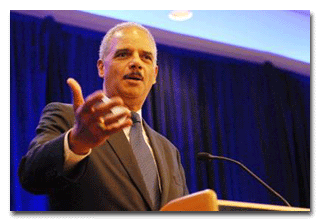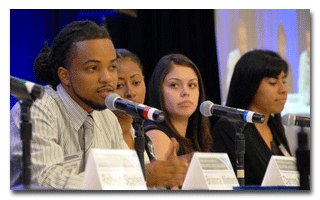

At the National Forum on Youth Violence Prevention's third annual summit on September 26–27, 2013, Administration officials, Congressmen, mayors, police chiefs, community advocates, and youth from 10 cities shared their strategies to reduce and mitigate the impact of violence on our nation's youth.
Homicide disproportionately affects individuals ages 10–24 in the United States and consistently ranks in the top three leading causes of death in this age group. According to a study funded by OJJDP with support from the Centers for Disease Control and Prevention, more than 60 percent of American children and adolescents are exposed to violence, crime, or abuse either as a victim or witness. Nearly 50 percent were assaulted at least once in the past year.

On the summit's opening day, Attorney General Eric Holder, Director of the White House Domestic Policy Council Cecilia Muñoz, and Assistant Attorney General for the Office of Justice Programs (OJP) Karol V. Mason stressed the Administration's commitment to addressing the lifelong consequences of exposure to violence.
"Children [exposed to violence] often face elevated risks of failing in school, suffering from anxiety and depression, or turning to drug or alcohol abuse later in life," said Attorney General Holder. "They are more likely than their peers to develop chronic illnesses or have difficulty forming emotional attachments. And far too many continue the cycle of violence by harming others."
Assistant Attorney General for OJP Mason underscored the summit's theme, "Building Toward a Safe and Healthy Tomorrow," by pointing to recent research that is shedding new light on what can be done to counter the negative effects of exposure to violence and trauma.
"Many of us have begun to institute some of these evidence-based approaches in our own spheres of work," Mason said. "Our challenge now is to bring all these efforts together—to coordinate our activities so that we're prepared to address these developmental needs at every phase of the service delivery system."

Later in the summit's first day, youth leaders told participants what they are doing in their communities to ensure brighter futures for themselves and their peers. The youth were from Chicago, IL; Memphis, TN; New Orleans, LA; Philadelphia, PA; Salinas, CA; and San Jose, CA, the communities involved in the Administration's violence prevention initiatives, including the National Forum on Youth Violence Prevention, Defending Childhood, Community-Based Violence Prevention, and Striving To Reduce Youth Violence Everywhere, commonly known as STRYVE.
Principal Deputy Assistant Attorney General Mary Lou Leary led mayors and other city leaders from Boston, Chicago, Detroit, Memphis, Salinas, and San Jose in a discussion about putting in place a comprehensive plan to address youth violence. The officials described how they align this work with other federal initiatives and how federal efforts are helping them achieve success and confront remaining challenges.
OJJDP Administrator Robert L. Listenbee introduced a panel discussion among the forum's federal partners on the critical importance of cross-sector collaboration to address the many causes and facets of youth violence. Federal leadership included U.S. Department of Education Secretary Arne Duncan, Office of National Drug Control Policy Director Gil Kerlikowske, and Deputy Assistant Secretary of the U.S. Department of Housing and Urban Development Calvin Johnson.
Congressional speakers included Christopher S. Murphy, U.S. Senator, Connecticut; Robert C. Scott, U.S. Representative, Virginia; and Chaka Fattah, U.S. Representative, Pennsylvania.
During the summit, mayors from the four cities that recently joined the forum—Camden, NJ; Minneapolis, MN; New Orleans, LA; and Philadelphia, PA—unveiled their comprehensive plans to address youth violence by using not only enforcement, but also prevention, intervention, and reentry strategies. Mayors from the other six cities in the forum shared their insights about how to sustain a comprehensive plan to address youth violence. The discussion also explored how federal efforts are helping these cities achieve success and confront remaining challenges.
Breakout sessions at the summit covered a range of topics, including—
- Faith-based and law enforcement partnerships
- Street outreach: Cure Violence, CeaseFire, and other evidence-based programs
- Sustainability
- Positive behavior interventions and supports
- Youth leadership development
- Public-private collaborations
- Youth employment strategies
- Supportive school discipline
Created in 2010 at the direction of President Obama, the forum is active in Boston, Chicago, Detroit, Memphis, Salinas, San Jose, New Orleans, Philadelphia, Minneapolis, and Camden. It models a new kind of federal and local collaboration, encouraging its members to change the way they do business by sharing common challenges and promising strategies through comprehensive planning and coordinated action. The U.S. Departments of Justice, Education, Health and Human Services, Housing and Urban Development, and Labor, as well as the White House Office of National Drug Control Policy, and the Corporation for National and Community Service are the forum's federal partners.
Resources:
More details about the forum, summaries of the cities' plans, and a strategic planning toolkit are available at FindYouthInfo.gov. A blog about the forum event posted by Assistant Attorney General for OJP Mason is available on the Department of Justice Web site. Information about the Administration's other youth violence prevention efforts—Defending Childhood, Community-Based Violence Prevention, and STRYVE—is also available online.